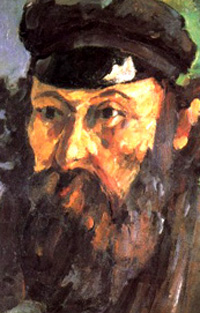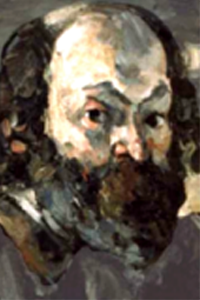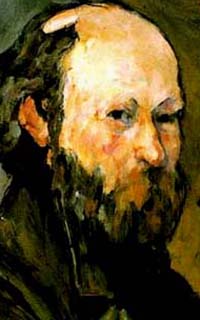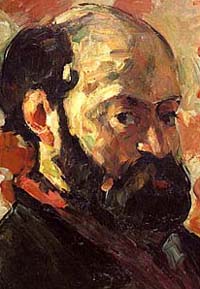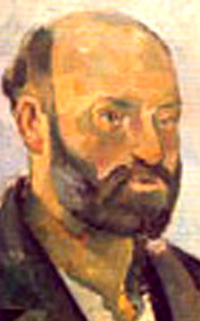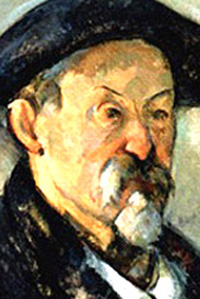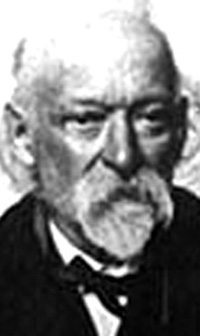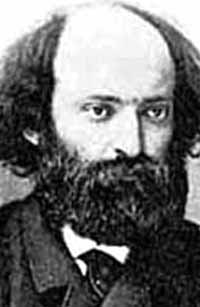Paul Cezanne
Copyright Michael D. Robbins 2005
Astro-Rayological Interpretation & Charts
Quotes
Biography
Images and Physiognomic Interpretation
Paul Cezanne, Impressionistic Artist
January 19, 1838, Aix-en-Provence, France 1:00 AM. (Source: Gauquelin) Died, October 22, 1906, Aix-en-Provence, France.

(Ascendant: Scorpio; MC in Leo; Sun in Capricorn with Mercury also in Capricorn; Moon in Pisces conjunct Uranus in Pisces with NN also in Pisces; Venus conjunct Neptune both in Aquarius; Mars in Virgo; Jupiter in Libra; Saturn in Sagittarius; Pluto in Aries)
A work of art which did not begin in emotion is not art.
(Sun conjunct Venus & Neptune.)The awareness of our own strength makes us modest.
We live in a rainbow of chaos.
When I judge art, I take my painting and put it next to a God made object like a tree or flower. If it clashes, it is not art.
I am old and ill, and I have sworn to die painting.
With an apple I will astonish Paris.
(Leo on MC.)Art is a harmony parallel with nature.
One had to immerse oneself in one's surroundings and intensely study nature or one's subject to understand how to recreate it.
I thought that by leaving Aix I should leave behind the boredom that pursues me. Actually I have done nothing but change my abode and the boredom has followed me.
When a picture isn't realized, you pitch it in the fire and start another one!
(Moon conjunct Uranus.)There is no model; there is only color.
Nature is more depth than surface. Hence the need to introduce into our light vibrations represented by the reds and yellows, a sufficient amount of blue to give the impression of air.
When the color achieves richness, the form attains its fullness also.
There is a logic of colors, and it is with this alone, and not with the logic of the brain, that the painter should conform.
I am progressing very slowly, for nature reveals herself to me in very complex forms; and the progress needed is incessant.
(Capricorn Sun.)Time and reflection... modify, little by little, our vision, and at last comprehension comes to us.
(Saturn square Moon.)Michelangelo is a constructor, and Rafael an artist who, great as he is, is always limited by the model. When he tries to be thoughtful he falls below the niveau of his great rival.
The artist must scorn all judgment that is not based on an intelligent observation of character. He must beware of the literary spirit which so often causes a painting to deviate from its true path – the concrete study of nature – to lose itself all too long in intangible speculations.
I have made some progress. Why so late and with such difficulty? Is art really a priesthood that demands the pure in heart who must belong to it entirely?
(Saturn square Moon/Uranus.)The contour eludes me.
(Pisces Moon.)Drawing and colour are not separate at all; in so far as you paint, you draw. The more the colour harmonizes, the more exact the drawing becomes.
All my compatriots are asses compared to me.
(Mars in 11th house.)The strong experience of nature... is the necessary basis for all conception of art on which rests the grandeur and beauty of all future work.
The knowledge of the means of expressing our emotions is only acquired through very long experience.
Get to the heart of what is before you and continue to express yourself as logically as possible.
(Venus in Aquarius conjunct Capricorn Sun.)One is neither too scrupulous nor too sincere nor too submissive to nature; but one is more or less master of one's model, and, above all, of the means of expression.
I have to keep working, not to arrive at finish, which arouses the admiration of fools... I must seek completion only for the pleasure of being truer and more knowing.
(Venus & Sun in 3rd house.)To paint is not to copy the object slavishly, it is to grasp a harmony among many relationships.
(Sun conjunct Venus.)When [paintings] are done right, harmony appears by itself. The more numerous and varied they are, the more the effect is obtained and agreeable to the eye.
Everything we see falls apart, vanishes. Nature is always the same, but nothing in her that appears to us, lasts. Our art must render the thrill of her permanence along with her elements, the appearance of all her changes. It must give us the taste of her eternity.
I wish to die painting.
Light is a thing that cannot be reproduced, but must be represented by something else – by color.
An optical impression is produced on our organs of sight which makes us classify as light, half-tone or quartertone, the surfaces represented by colour sensations. So that light does not exist for the painter.
I advance all of my canvas at one time.
Treat nature by the cylinder, the sphere, the cone, everything in proper perspective so that each side of an object or a plane is directed towards a central point.
Studying the model and realizing it is sometimes very slow in coming for the artist.
What I am trying to translate to you is more mysterious; it is entwined in the very roots of being, in the implacable source of sensations.
I have not tried to reproduce nature: I have represented it.
In order to make progress, there is only nature, and the eye is turned through contact with her.
The Louvre is a good book to consult, but it must only be an intermediary. The real and immense study that must be taken up is the manifold picture of nature.
What is one to think of those fools who tell one that the artist is always subordinate to nature? Art is a harmony parallel with nature.
To be sure an artist wishes to raise his standard intellectually as much as possible, but the man must remain in obscurity. Pleasure must be found in the studying.
(Venus in 3rd house.)He unfolds, as a painter, that which has not yet been said; he translates it into absolute terms of painting – something other than reality.
Literature expresses itself by abstractions, whereas painting, by means of drawing and colour, gives concrete shape to sensations and perceptions.
(Capricorn Sun.)Painting from nature is not copying the object; it is realizing one's sensations.
Pleasure must be found in study.
All pictures painted inside in the studio will never be as good as the things done outside.
I am not altogether displeased with the shirt-front. [after 115 sittings for a portrait of Ambroise Vollard]
There is no such thing as an amateur artist as different from a professional artist. There is only good art and bad art.
To achieve progress nature alone counts, and the eye is trained through contact with her. It becomes concentric by looking and working.
I wished to copy nature. I could not. But I was satisfied when I discovered the sun, for instance, could not be reproduced, but only represented by something else.
I cannot attain the intensity that is unfolded before my senses. I have not the magnificent richness of colouring that animates nature.
I am still searching for the expression of those confused sensations that we bring with us at birth.
(Mars conjunct South Node in 11th house.)One must see one's model correctly and experience it in the right way; and furthermore express oneself forcibly and with distinction.
Monet is only an eye, but my God, what an eye!
One can do good things without being very much of a harmonist or a colourist. It is sufficient to have a sense of art – and this sense is doubtless the horror of the bourgeois.
My nervous system is very much weakened – nothing but painting in oil can keep me going.
Taste is the best judge. It is rare. Art only addresses itself to an excessively small number of individuals.
Painting is nature seen through a temperament.
Right now a moment of time is fleeting by! Capture its reality in paint... We must become that moment, make ourselves a sensitive recording plate... give the image of what we actually see, forgetting everything that has been seen before our time.
There is no light painting or dark painting, but simply relations of tones.
Talks on art are almost useless. The work which goes to bring progress in one's own subject is sufficient compensation for the incomprehension of imbeciles.
The painter unfolds that which has not been seen.
The Louvre is the book in which we learn to read.
It took me 40 years to find out that painting is not sculpture.
Don't be an art critic, but paint, there lies salvation.
All my life I have worked to be able to earn my living, but I thought that one could do good painting without attracting attention to one's private life. Certainly, an artist wishes to raise himself intellectually as much as possible, but the man must remain obscure. The pleasure must be found in the work.
It's so fine and yet so terrible to stand in front of a blank canvas.
There are two things in the painter, the eye and the mind; each of them should aid the other.
Painting, like any art, comprises a technique, a workmanlike handling of material, but the accuracy of a tone and the flicitous combination of effects depend entirely on the choice made by the artist."
Style is not created through servile imitation of the masters; it procees from the artist's own particular way of feeling and expressing himself.
"Genius is the ability to renew one's emotions in daily experience.
The artist makes things concrete and gives them individuality.
Doubtless there are things in nature which have not yet been seen. If an artist discovers them, he opens the way for his successors. If I have left something unsaid, they will say it.
God knows how the Old Masters got through those acres of work ... I exhaust myself, work myself to death trying to cover fifty centimetres of canvas.
Painting is damned difficult ... you always think you've got it, but you haven't.
I could paint for a hundred years, a thousand years without stopping and I would still feel as though I knew nothing.
Fruits ... like having their portrait painted. They seem to sit there and ask your forgiveness for fading. Their thought is given off with their perfumes. They come with all their scents, they speak of the fields they have left, the rain which has nourished them, the daybreaks they have seen."
Cézanne was born in Aix-en-Provence and went to school there. From 1859 to 1861 he studied law, while continuing drawing lessons. Against the objections of his father, he decided to pursue an artistic career and left for Paris with his friend Émile Zola in 1861. Gradually, his father reconciled to his course of life and supported him in it. He later received a large inheritance, on which he could live with ease.
In Paris, he met Camille Pissarro and other impressionists.
Cézanne began with the light, airy painting of the impressionists, but gradually solidified it and made it more architectural. In his words: "I want to make of impressionism something solid and lasting like the art in the museums." He structurally ordered whatever he perceived into simple forms and colour planes to create the most telling image of the subject matter. His geometric essentialisation of forms influenced cubism, in particular.
His paintings were in the first exhibition of the Salon des Refusés in 1863, which displayed works not accepted by the jury of the official Paris Salon. The Paris Salon rejected Cézanne's submissions every year from 1864 to 1869.
He exhibited little in his lifetime and worked in increasing artistic isolation, remaining in the South of France far from Paris. He concentrated on a few subjects: still lifes, studies of bathers, and especially the Mont Sainte-Victoire, of which he painted innumerable views.
Cézanne and Zola disagreed, and never reconciled, over Zola's fictionalized depiction of Cézanne in the novel L'Oeuvre (The Masterpiece, 1886).
In 1906, Cézanne collapsed while painting in the outdoors during a thunderstorm. One week later, on October 22, he died of pneumonia.
On May 10, 1999, Cézanne's painting Rideau, cruchon et compotier sold for $60.5 million, the fourth highest price paid for a painting up to that time.
Visionary ahead of his time, Cezanne's innovative style, use of perspective, composition and color profoundly influenced 20th century art. Picasso developed Cezanne's planar compositions into cubism, and Matisse greatly admired his use of color. He used color with passion and creativity, giving his brush strokes structure, solidity, durability. Pablo Picasso said the following of the artist "My one and only master . . . Cezanne was like the father of us all". Cezanne is therefore often described as the "father of modern art". Unfortunately, Cezanne was the ultimate outsider and misunderstood during most of his life. Success came little and late, although young promising painters came to visit him during his last years.
born on January 19, 1839, as the son of a wealthy banker in the southern French town of Aix-en-Provence. Cezanne develops artistic interest at an early age and joins his boyhood companion and author Emile Zola in Paris in 1861, after many disputes with his father over his desire to dedicate himself to painting. Cezanne's stay in Paris lasted only six months. Though attracted by the more radical art forms in Paris, admiring the innovating works by Eugène Delacroix, Gustave Courbet and Edouard Manet, he destroys many canvases during depressive moments and returns home full of self-doubt. A year spent working with his father, however, convinced him to try a painter's life again. Cezanne's early works were dark and composed of heavy, fluid pigment suggesting the moody, romantic expression of previous generations.
Cezanne returns to Paris suffering a new defeat when failing the entrance exam for the Ecole des Beaux-Arts. Worse, his paintings are rejected by the Salon. Thanks to Pissarro, he is introduced to Impressionist painters such as Manet and Degas.
1870
At 30, Cezanne changes his style and his habits. He meets Hortense Fiquet who becomes his mistress for many years. The black and morbid atmosphere of his painting gradually changes as he concentrates on landscape subjects. This period is also known as "constructive", characterized by the grouping of parallel, hatched brushstrokes that have the power to build a feeling of mass. After the birth of his son, Cezanne moved with his family to Pontoise, where Pissarro lived. For two years the two men spent long periods together. Pissarro introduces him to Impressionist painting and his work is finally exhibited together with other Impressionist works in 1874.
Pissarro's influence is seen through the somewhat lightened palette. Throughout his career, will faithfully keep painting directly from nature. However, Cezanne reacted against the lack of structure in the Impressionist paintings and said that he intended to make Impressionism into "something solid and durable, like the art of the museums". He did innovate beyond Impressionism and is ranked alongside the Post-Impressionist artists Seurat, Van Gogh and Gauguin.
For many years, still-lifes and landscapes were Cezanne's main topics. Composing more than 200 still-life paintings, Cezanne wants to 'conquer Paris with an apple'. 'Apples and Oranges' is one of his most famous still-life compositions. Applying the same methodical analysis to these works as he did with his landscapes, Cezanne records the slightest variations in tone and color observed over long periods as well as the forms from empirical geometry he considered the most frequent in nature - the 'cylinder, sphere and the cone'.
In 1881, Cezanne's brother-in-law bought a house with a view on the Saint-Victoire mountain. He feels this mountain in his compositions is the essence of all that he had felt had eluded the Impressionists - firmness, solidity, permanence.
When in 1886 Emile Zola's publishes L'Oeuvre, Cezanne was deeply hurt by the resemblances to the main character, which was a failed artist. This leads to the end of his friendship with Zola. In the same year, Cezanne reveals the existence of his family to his parents and then marries Hortense. Later that year, Cezanne's father dies, leaving him a comfortable inheritence.
The next few years, Cezanne becomes increasingly isolated from his family in Paris while he stays in Aix. Cutting himself off from the outer world, he lives the life of a recluse.
1890 In his late fifties however, Cezanne's work finally began to attract the attention it deserves. Ambroise Vollard, a renowned art dealer, organises an exhibit of Cezanne's work in Paris in 1895. Appreciation and acceptance of his innovative work follows, and Vollard even buys every painting from Cezanne's studio in 1897. Young artists travel to Aix to see him at work.
Cezanne's artistic search leads him to study the same subjects over and over, varying his approach each time. 'The Great Bathers', a monumental piece showing women in a landscape, is a revision of a favourite subject, first explored in 1875.
In later years, Cezanne's health detriorated. On October 22 1906, Cezanne dies of pneumonia.
Cezanne, Paul (1839-1906), French painter, often called the father of modern art, who strove to develop an ideal synthesis of naturalistic representation, personal expression, and abstract pictorial order.
Among the artists of his time, Cezanne perhaps has had the most profound effect on the art of the 20th century. He was the greatest single influence on both the French artist Henri Matisse, who admired his use of color, and the Spanish artist Pablo Picasso, who developed Cezanne's planar compositional structure into the cubist style. During the greater part of his own lifetime, however, Cezanne was largely ignored, and he worked in isolation. He mistrusted critics, had few friends, and, until 1895, exhibited only occasionally. He was alienated even from his family, who found his behavior peculiar and failed to appreciate his revolutionary art.
II. Early Life and Work
Cezanne was born in the southern French town of Aix-en-Provence, January 19, 1839, the son of a wealthy banker. His boyhood companion was emile Zola, who later gained fame as a novelist and man of letters. As did Zola, Cezanne developed artistic interests at an early age, much to the dismay of his father. In 1862, after a number of bitter family disputes, the aspiring artist was given a small allowance and sent to study art in Paris, where Zola had already gone. From the start he was drawn to the more radical elements of the Parisian art world. He especially admired the romantic painter Eugène Delacroix and, among the younger masters, Gustave Courbet and the notorious Edouard Manet, who exhibited realist paintings that were shocking in both style and subject matter to most of their contemporaries.III. Influence of the Impressionists
Many of Cezanne's early works were painted in dark tones applied with heavy, fluid pigment, suggesting the moody, romantic expressionism of previous generations. Just as Zola pursued his interest in the realist novel, however, Cezanne also gradually developed a commitment to the representation of contemporary life, painting the world he observed without concern for thematic idealization or stylistic affectation. The most significant influence on the work of his early maturity proved to be Camille Pissarro, an older but as yet unrecognized painter who lived with his large family in a rural area outside Paris. Pissarro not only provided the moral encouragement that the insecure Cezanne required, but he also introduced him to the new impressionist technique for rendering outdoor light. Along with the painters Claude Monet, Auguste Renoir, and a few others, Pissarro had developed a painting style that involved working outdoors (en plein air) rapidly and on a reduced scale, employing small touches of pure color, generally without the use of preparatory sketches or linear outlines. In such a manner Pissarro and the others hoped to capture the most transient natural effects as well as their own passing emotional states as the artists stood before nature. Under Pissarro's tutelage, and within a very short time during 1872-1873, Cezanne shifted from dark tones to bright hues and began to concentrate on scenes of farmland and rural villages.IV. Return to Aix-en-Provence
Although he seemed less technically accomplished than the other impressionists, Cezanne was accepted by the group and exhibited with them in 1874 and 1877. In general the impressionists did not have much commercial success, and Cezanne's works received the harshest critical commentary. He drifted away from many of his Parisian contacts during the late 1870s and '80s and spent much of his time in his native Aix-en-Provence. After 1882, he did not work closely again with Pissarro. In 1886, Cezanne became embittered over what he took to be thinly disguised references to his own failures in one of Zola's novels. As a result he broke off relations with his oldest supporter. In the same year, he inherited his father's wealth and finally, at the age of 47, became financially independent, but socially he remained quite isolated.V. Cezanne's Use of Color
This isolation and Cezanne's concentration and singleness of purpose may account for the remarkable development he sustained during the 1880s and '90s. In this period he continued to paint studies from nature in brilliant impressionist colors, but he gradually simplified his application of the paint to the point where he seemed able to define volumetric forms with juxtaposed strokes of pure color. Critics eventually argued that Cezanne had discovered a means of rendering both nature's light and nature's form with a single application of color. He seemed to be reintroducing a formal structure that the impressionists had abandoned, without sacrificing the sense of brilliant illumination they had achieved. Cezanne himself spoke of “modulating” with color rather than “modeling” with dark and light. By this he meant that he would replace an artificial convention of representation (modeling) with a more expressive system (modulating) that was closer still to nature, or, as the artist himself said, “parallel to nature.” For Cezanne, the answer to all the technical problems of impressionism lay in a use of color both more orderly and more expressive than that of his fellow impressionists.Cezanne's goal was, in his own mind, never fully attained. He left most of his works unfinished and destroyed many others. He complained of his failure at rendering the human figure, and indeed the great figural works of his last years—such as the Large Bathers (circa 1899-1906, Museum of Art, Philadelphia) —reveal curious distortions that seem to have been dictated by the rigor of the system of color modulation he imposed on his own representations. The succeeding generation of painters, however, eventually came to be receptive to nearly all of Cezanne's idiosyncrasies. Cezanne's heirs felt that the naturalistic painting of impressionism had become formularized, and a new and original style, however difficult it might be, was needed to return a sense of sincerity and commitment to modern art.
VI. Significance of Cezanne's Work
For many years Cezanne was known only to his old impressionist colleagues and to a few younger radical post-impressionist artists, including the Dutch painter Vincent van Gogh and the French painter Paul Gauguin. In 1895, however, Ambroise Vollard, an ambitious Paris art dealer, arranged a show of Cezanne's works and over the next few years promoted them successfully. By 1904, Cezanne was featured in a major official exhibition, and by the time of his death (in Aix-en-Provence on October 22, 1906) he had attained the status of a legendary figure. During his last years many younger artists traveled to Aix-en-Provence to observe him at work and to receive any words of wisdom he might offer. Both his style and his theory remained mysterious and cryptic; he seemed to some a naive primitive, while to others he was a sophisticated master of technical procedure. The intensity of his color, coupled with the apparent rigor of his compositional organization, signaled to most that, despite the artist's own frequent despair, he had synthesized the basic expressive and representational elements of painting in a highly original manner.

